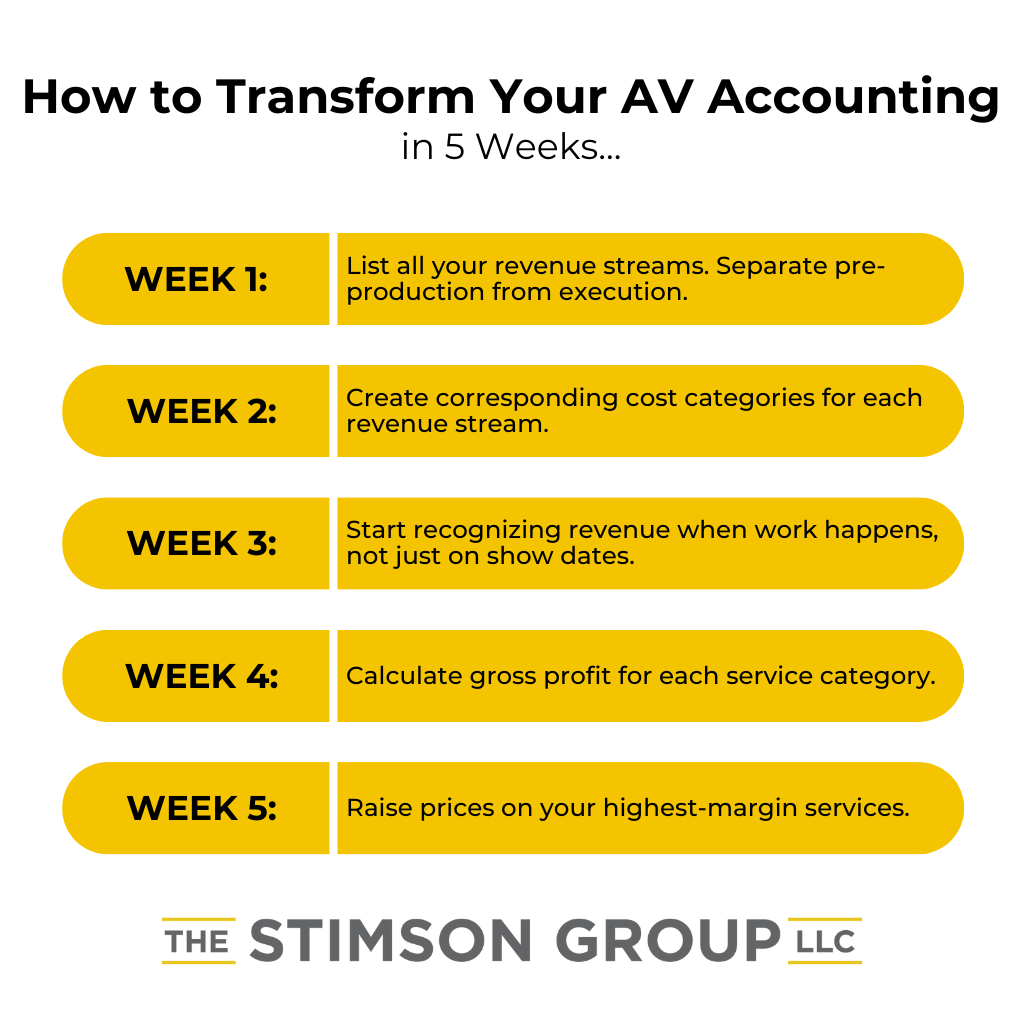
Listen instead on your Monday Morning Drive:
You think you’re seasonal because all your shows happen in certain months. You’re wrong. Your accounting makes you look more seasonal than you actually are.
Most AV companies still keep their books like equipment rental houses from 20 years ago: Income is recognized when the equipment returns. But you’re not renting gear anymore. You’re delivering services that happen months before the show date.
Fix your accounting, and watch half your seasonality disappear.
Your Books Don’t Match Your Business
Look at your P&L. It probably shows massive revenue spikes in your busy months and valleys in your slow months. That’s because you’re recording all revenue when shows happen, not when work gets done.
Here’s what’s actually happening in your business:
You start pre-production in January for an August show. You’re designing, planning, creating content, and managing the project for seven months. You book the show team in February. Make travel purchases in March. Schedule the truck in April. Buy supplies in May. Reserve the gear in your system in June and place subrentals up until the show.
Plus, you create drawings and revise them for months. Hire a graphics person to create the show template. Pay a designer to specify the signage and hire a fabricator to build it. These folks don’t wait to get paid.
But your books show zero revenue until August.
That $350,000 of pre-production on an $800,000 show? Your accounting dumps it all in August. Meanwhile, your team worked on it for months.
Your books make you look seasonal. Your business isn’t.
Separate Pre-Production From Show Execution
Pre-production is a different business from show execution: different people, different skills, different timing. Your accounting should reflect this.
Stop lumping all labor into one category. Stop treating design services like equipment rental. Stop pretending content creation happens on show day.
(Creative services have 70% margins. Equipment re-rental has 30% margins. Which would you rather sell?)
Create separate revenue categories for:
- Creative services
- Production management
- Content creation
- Show execution
- Equipment rental
Each category needs its own corresponding cost line. No exceptions.
Recognize Revenue When Work Happens
If you design a show in March, that’s March revenue.
Spreading pre-production revenue across the months when work actually happens flattens 20–25% of your revenue curve. You’re still busy in August, but now your books show you’ve been busy since January.
This isn’t creative accounting. This is accurate accounting.
Your project managers work on shows for months before load-in. Your designers create concepts weeks before rehearsals. Your content team delivers videos long before doors open.
Recognize that revenue when it happens.
Match Every Dollar of Revenue to Its Cost
Every income category needs a corresponding expense category. No orphan revenue. No mystery costs.
If you have 12 income categories, you need at least 12 cost categories. Maybe 14. Your accountant will figure out the extra two.
This direct correlation shows you exactly where you make money… and where you don’t.
(That pass-through trucking you don’t mark up? It’s costing you 10% gross margin on the entire project.)
Stop Mixing Overhead With Direct Costs
Your favorite video editor who also handles marketing is both overhead and a direct cost. Track their time. Split their salary accordingly.
“But Tom, our employees don’t track time!”
Every professional services firm tracks time. Employees who can’t tell you what they worked on this week are doing too many wrong things.
Time tracking finds your problem employees. The ones with their fingers in too many pies. The ones creating bottlenecks. The ones costing you profit.
The Three Problems This Strategy Solves
1. Fake Seasonality
When you recognize pre-production revenue monthly, your revenue curve flattens. You’re still busier in peak months, but the valleys aren’t as deep.
Your business runs year-round. Your books should show that.
2. Hidden Profit Centers
Pre-production services carry massive margins when priced correctly. But if you bundle them with show execution, you never see it. Separate them, and suddenly you know exactly which services drive profit.
3. Pricing Paralysis
You can’t charge $300/hour for senior design work when the same person bills $75/hour for show supervision.
Separate the services, and you can price each appropriately.
Make Your Reports Actionable
If you need a report to explain your report, your accounting is broken.
Every line on your P&L should tell you something useful. Every number should drive a decision. Every report should answer a question.

Bad accounting creates bad decisions. You think you’re seasonal, so you don’t market in slow months. You think equipment drives profit, so you buy more gear. You think you can’t raise prices, so you eat inflation.
Good accounting uncovers truths: you work year-round, services drive profit, your prices are too low, etc.

Start Today
You don’t need to fix your books forever. Just back to January 1 of this year.
You don’t need to stay in your current accounting system. Data can move between platforms.
You don’t need your accountant’s permission. (Though their discomfort might be telling.)
Here’s your action plan:
- Week 1: List all your revenue streams. Separate pre-production from execution.
- Week 2: Create corresponding cost categories for each revenue stream.
- Week 3: Start recognizing revenue when work happens, not just on show dates.
- Week 4: Calculate gross profit for each service category.
- Week 5: Raise prices on your highest-margin services.
Your business evolved from equipment rentals to professional services. Your accounting needs to catch up.
Fix your books. Kill fake seasonality. Find your profit.
These specialized services and accurate accounting actually add value.





Leave a Reply